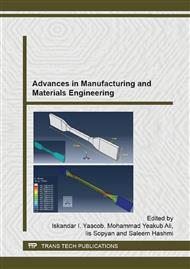p.418
p.422
p.426
p.433
p.440
p.446
p.450
p.454
p.458
Active Vehicle Suspension Control Using Full State-Feedback Controller
Abstract:
The main purpose of vehicle suspension system is to isolate the vehicle main body from any road geometrical irregularity in order to improve the passengers ride comfort and to maintain good handling stability. The present work aim at designing a control system for an active suspension system to be applied in today’s automotive industries. The design implementation involves construction of a state space model for quarter car with two degree of freedom and a development of full state-feedback controller. The performance of the active suspension system was assessed by comparing it response with that of the passive suspension system. Simulation using Matlab/Simulink environment shows that, even at resonant frequency the active suspension system produces a good dynamic response and a better ride comfort when compared to the passive suspension system.
Info:
Periodical:
Pages:
440-445
Citation:
Online since:
July 2015
Authors:
Keywords:
Price:
Сopyright:
© 2015 Trans Tech Publications Ltd. All Rights Reserved
Share:
Citation:


